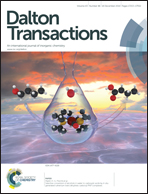A series of divalent metal coordination polymers based on isomeric tetracarboxylic acids: synthesis, structures and magnetic properties†
Abstract
Five new coordination polymers, namely, [Mn(2,2′-bipy)(H2O)2(H2L1)]n (1), {[Co(btb)(H2O)2(H2L1)]·0.5H2O}n (2), [Co(bib)(H2O)2(H2L1)]n (3), [Ni2(bpm)(H2O)3(L2)]n (4), and {[Co2(H2O)3(OH)(HL2)]·H2O}n (5), (H4L1 = 1,1′:2′,1′′-terphenyl-4,4′,4′′,5′-tetracarboxylic acid, H4L2 = 1,1′:2′,1′′-terphenyl-3,3′′,4′,5′-tetracarboxylic acid, 2,2′-bipy = 2,2′-bipyridine, btb = 1,4-bis(1,2,4-triazol-1-yl)butane, bib = 1,4-bis(imidazol-1-yl)butane, bpm = bis(4-pyridyl)amine), have been obtained under hydrothermal conditions. Complex 1 exhibits a 3D supramolecular framework based on 1D chains. Both complexes 2 and 3 are 3D supramolecular frameworks constructed from 1D zig-zag chains. Complex 4 features a 3D tetra-nodal (3,4,4,5)-connected architecture containing 1D μ-COO bridged chains with (52·62·7.9)(52·64·73·8)2(52·6)2(63·72·9) topology. Complex 5 shows a 3D penta-nodal (3,4,4,6,6)-connected net containing 1D μ-OH/μ-COO bridged chains and mononuclear Co(II) nodes with a (42·63·8)(43)2(44·62)2(44·66·85)2(44·67·84) topology. Variable-temperature magnetic susceptibility measurements reveal that complexes 2 and 3 show antiferromagnetic interactions between the adjacent Co(II) ions, whereas 4 is a ferromagnetic system.


 Please wait while we load your content...
Please wait while we load your content...